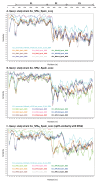Enhanced echovirus 11 genomic surveillance in neonatal infections in Spain following a European alert reveals new recombinant forms linked to severe cases, 2019 to 2023
- PMID: 39484685
- PMCID: PMC11528903
- DOI: 10.2807/1560-7917.ES.2024.29.44.2400221
Enhanced echovirus 11 genomic surveillance in neonatal infections in Spain following a European alert reveals new recombinant forms linked to severe cases, 2019 to 2023
Abstract
BackgroundIn 2023, a European alert was issued regarding an increase in severe enterovirus (EV) neonatal infections associated with echovirus 11 (E11) new lineage 1.AimTo analyse E11-positive cases between 2019 and 2023 to investigate whether the new lineage 1 circulated in Spain causing severe neonatal infections.MethodsEV-positive samples from hospitalised cases are sent for typing to the National Reference Enterovirus Laboratory. Available samples from 2022-23 were subjected to metagenomic next-generation sequencing.ResultsOf 1,288 samples genotyped, 103 were E11-positive (98 patients: 6 adults, 33 neonates, 89 children under 6 years; male to female ratio 1.9). E11 detection rate was similar before and after detection of the new lineage 1 in Spain in June 2022 (9.7% in 2019 vs 10.6% in 2023). The proportion of E11-infected ICU-admitted neonates in 2019-2022 (2/7) vs 2022-2023 (5/12) did not significantly differ (p = 0.65). In severe neonatal infections, 4/7 E11 strains were not linked to the new lineage 1. The three novel E11 recombinant genomes were associated with severe (n = 2) and non-severe (n = 1) cases from 2022-2023 and clustered outside the new lineage 1. Coinfecting pathogenic viruses were present in four of 10 E11-positive samples.ConclusionThe emergence of the new lineage 1 is not linked with an increase in incidence or severity of neonatal E11 infections in Spain. The detection of two novel E11 recombinants associated with severe disease warrants enhancing genomic and clinical surveillance.
Keywords: Enterovirus; echovirus 11; genomic surveillance; international alert; neonatal infection; new variant; recombinant.
Conflict of interest statement
Figures





References
MeSH terms
LinkOut - more resources
Full Text Sources
